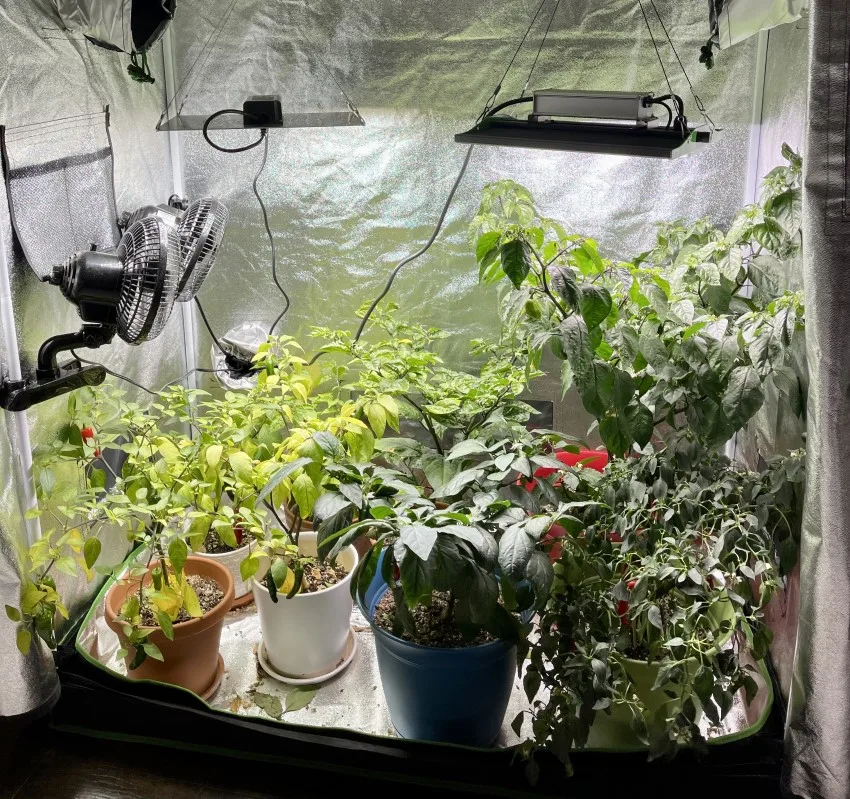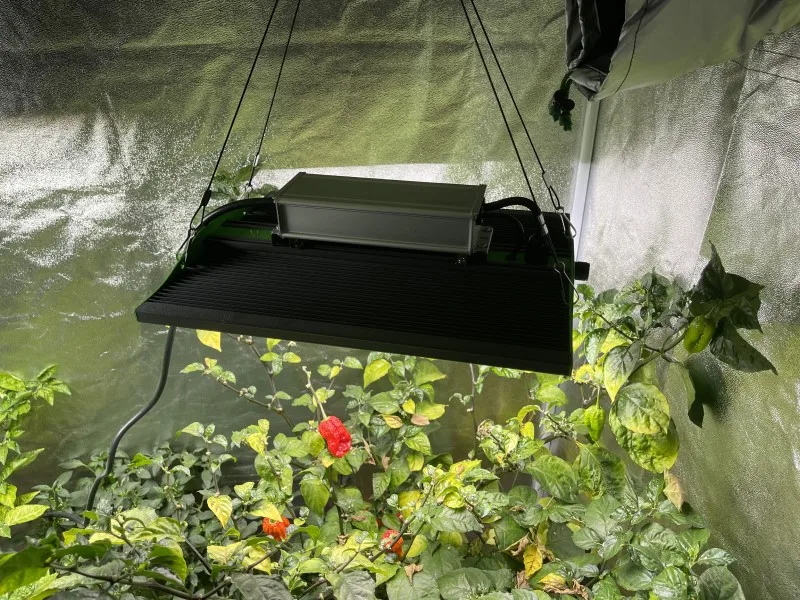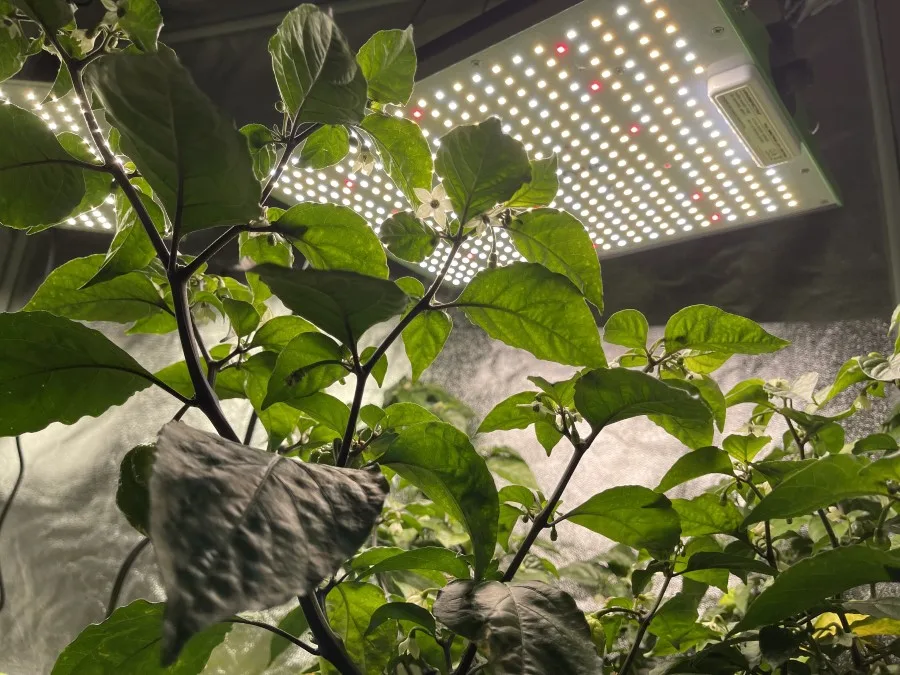Grow lights have become a more mainstream household item these days due to the rising popularity of indoor gardening. Keeping plants indoors improves a space’s aesthetics and gives you greater control over your indoor growing conditions. However, you may worry about the possible dangers of grow lights, particularly how the heat they emit can affect your plants.
All grow lights get hot because they all go through the process of converting energy to light. All objects that consume electric power will produce heat. The intensity of the heat varies depending on how efficient a grow light is in converting energy to light.
We will talk about how hot LED and HPS grow lights can get, which of them produces the most amount of heat, and if they have the potential to become fire hazards. We will also discuss the more common grow lights available and how to choose the best ones for your plants.
As an Amazon Associate, I earn from qualifying purchases.

Do LED Grow Lights Get Hot?
Light-Emitting Diodes (LED) grow lights get hot, but not as much as other lights. The lower heat output has to do with how efficient LED lights are in converting energy to light; LEDs can produce the same amount of light as standard light bulbs without using as much energy. Simply put, less energy means less heat.
Take a 10-watt LED grow light as an example: the light output is 8 watts, and the other 2 watts is converted into heat energy. For a 15-watt LED light, the actual output is 12 watts, while the heat generated is 3 watts. Energy is a property that cannot be created or destroyed—it merely changes its form.
The heat produced by grow lights converts to infrared radiation. It is a type of radiation that makes an object’s molecules heat up as soon as it hits them. In the case of plants, it is the infrared radiation from grow lights that can cause leaf burn when the heat is too intense.
Thanks to their energy conversion efficiency, LED grow lights function without emitting as much heat as florescent or HID (HPS) lights. You can mount them pretty close to your plants without worrying about leaf burn and heat stress (although you still need to take precautions not to have them sit too close to your plants). Compared to other lights, LED lights direct significantly less infrared radiation toward plants.
We measured the heat emitted from our LED grow lights using a contactless laser thermometer. After 8.5 hours, the LED lights without heat sinks HLG 100 V2 4000K Horticulture Lighting Group Quantum Board LED Grow Light Veg & Bloom measured at 115°F (46°C), while our lights with heat sinks VIPARSPECTRA P1500 LED Grow Light measured 95°F (35°C).
Do HPS Grow Lights Get Hot?
High-Pressure Sodium (HPS) grow lights get very hot and are not as efficient as LED lights. As opposed to LED lights, which produce more light per watt, much of this intense heat converts to infrared radiation. This radiation is why you should never mount your HPS lights too close above your plants—they will burn.
It only takes HPS grow lights 10-15 minutes to produce their brightest light and get very hot. That’s why they should be mounted at least 2-6 feet (0.5-2 m) away from your plants. This placement avoids heat stress and prevents your plants from getting burned.
Experts highly recommend HPS grow lights for flowering and fruiting plants due to the red spectrum lights they produce. Plants may even begin to fruit or flower sooner if they are grown indoors under HPS light than if they’re grown outdoors in natural conditions.
In fact, some gardeners bring their outdoor plants indoors as soon as they near their flowering or fruiting phase to encourage better blooms and larger fruits.

What Gets Hotter: LED or HPS Grow Lights?
HPS grow lights produce significantly more heat than LED grow lights. Take a 1,000-watt HPS grow light, for instance. You can replace this with a 600-watt LED grow light and get the same amount of light, plus reduce the heat in the room by about 40%.
LED grow lights generate significantly less heat than HPS grow lights. Due to their lower heat signature, you may mount them as close as 6 inches (15 cms) away from your plants’ tops, depending on how intense the LEDs are and what plants you are growing. Adjust and experiment until you determine the ideal distance for your plants to thrive.
Remember that plants have different needs, so it is best to tailor your approach when it comes to proper lighting and care.
Are Grow Lights Fire Hazards?
Grow lights are potential fire hazards because they are electricity-intensive appliances. They can generate a significant amount of heat over time, especially if they are used daily for at least eight hours. Grow lights can be dangerous if you use them improperly and carelessly.
Here are some safety precautions to consider so your indoor garden setup won’t be a threat to your safety:
- Call an expert to do the wiring if your setup is complicated. Do not attempt to do the wiring yourself if you do not have experience in electrical circuits. Professionals can show you how to do it properly as poor wiring and overloaded circuits may lead to fires.
- Inspect the wiring periodically. Ensure that your grow lights stay in good condition and that there are no loose and damaged wires.
- Regularly inspect your grow lights. Be on the lookout for any signs of damage. Damaged parts may produce intense or unnecessary heat and eventually cause a fire.
- Never mix water and electricity. It is not odd for grow lights to be situated near water since water is essential to plant growth. However, remember that water can short circuit your wiring and can also cause electrocution.
- Check your grow lights’ immediate surroundings. Get rid of items that may cause fire when in close contact to heat, such as paper and fabrics. For instance, if one of your curtains rests on a grow light after being blown about by the wind, that’s a fire hazard.
How to Tell if the Heat From Your Grow Lights is Too Much
Your plants will let you know if the heat they are getting from your grow lights is becoming bothersome. There are telltale signs you can’t miss which is why it is important to develop a habit of regularly inspecting your plants. This way, you’ll quickly notice changes in texture, color, or if your plant is losing leaves.
These overheating signs usually manifest first in the areas closest to the grow lights. They will then gradually work their way to the rest of the plant if you don’t address the issue.
Here are six signs that your plants are getting too much heat from your grow lights:
- Browning leaf tips
- Yellowing leaves
- Curling leaves
- Brown spots on stems
- Wilting stems and leaves
- Your plant’s leaves are dropping, especially from the top
Adjust the distance between your grow lights and plants as soon as you detect signs of heat stress.

How to Choose the Best Type of Grow Lights for Your Plants
Grow lights help make indoor gardening more manageable and more rewarding. Remember that the purpose of grow lights is to mimic the amount of sunlight plants enjoy in their natural habitat. The key to choosing the best type of grow lights for your plants is to understand their unique needs so you can provide them with the best possible environment for growth.
Here are the common types of grow lights you will find in the market:
Fluorescent Grow Lights
Fluorescent grow lights are durable and relatively inexpensive. They are best suited for growing various vegetables, especially those that do not need too much light to thrive. They come in two forms: compact fluorescent lights and tube fluorescent lights.
Fluorescent lights are four times cooler than traditional yellow bulbs and can probably get to about 100°F (38°C). They are less efficient than LED lights, but more efficient than HID ones.
High-Intensity Discharge (HID)
High-Intensity Discharge grow lights were probably the most commonly used lights for indoor gardens, until LEDs became more popular. HID lights can best imitate the sun, affording your indoor garden an environment similar to an outdoor garden. HID lights emit the most amount of heat when compared to fluorescent and LED options. HID grow lights include:
- Metal Halide (MH). MH grow lights emit violet and blue light spectrums, mimicking springtime’s natural outdoor light structure.
- High-Pressure Sodium (HPS). HPS grow lights are the most efficient of HID lights. They primarily emit a red light spectrum, ideal for a plant’s flowering and fruiting phase.
Light Emitting Diodes (LEDs)
LED grow lights provide a complete and balanced light spectrum that mimics natural light outdoors. You may use them for different plants in various growth phases. They are the most energy-efficient, too. LED lights also don’t emit as much heat as either fluorescent or HID options.
3 factors to consider when choosing which grow lights to use for your indoor plants:
In most cases, we recommend using LED lights and you can check out this post that goes in to more details on why they are generally superior to HPS lights. However, here are three factors to consider when deciding which grow lights to go with:
- Types of plants you have. Not all grow lights are created equal, and there is no specific type of grow light that can be considered the best overall choice. Grow lights offer different light spectrums and various heat levels to cater to the needs of different plants.
- Your indoor garden setup. Space and ventilation are essential factors when setting up your indoor garden. Select grow lights that complement your space and won’t be overbearing for your plants. LED lights are generally better for smaller spaces, since they can be placed relatively closer to your plants.
- Energy consumption expectations. You might notice your monthly electric bills rise along with your continuous and regular use of grow lights. If you’re not keen on making a dent in your wallet, go for grow lights that are more energy efficient, such as LEDs.
Key Takeaways
Grow lights are great for mimicking the sun and allowing indoor plants to photosynthesize properly. No matter which type of grow light you choose, expect that they will contribute to the heat around your plants and within the room. Some plants will thrive in this heat, while some will wither.
The key is to be aware of the various needs of each of your plants. This way, you could provide them with the appropriate care and environment they need. Using your grow lights correctly will be a valuable tool in growing your indoor plants.
